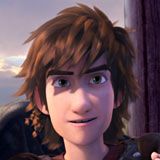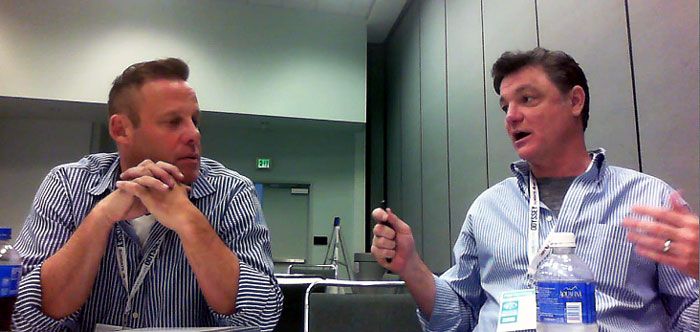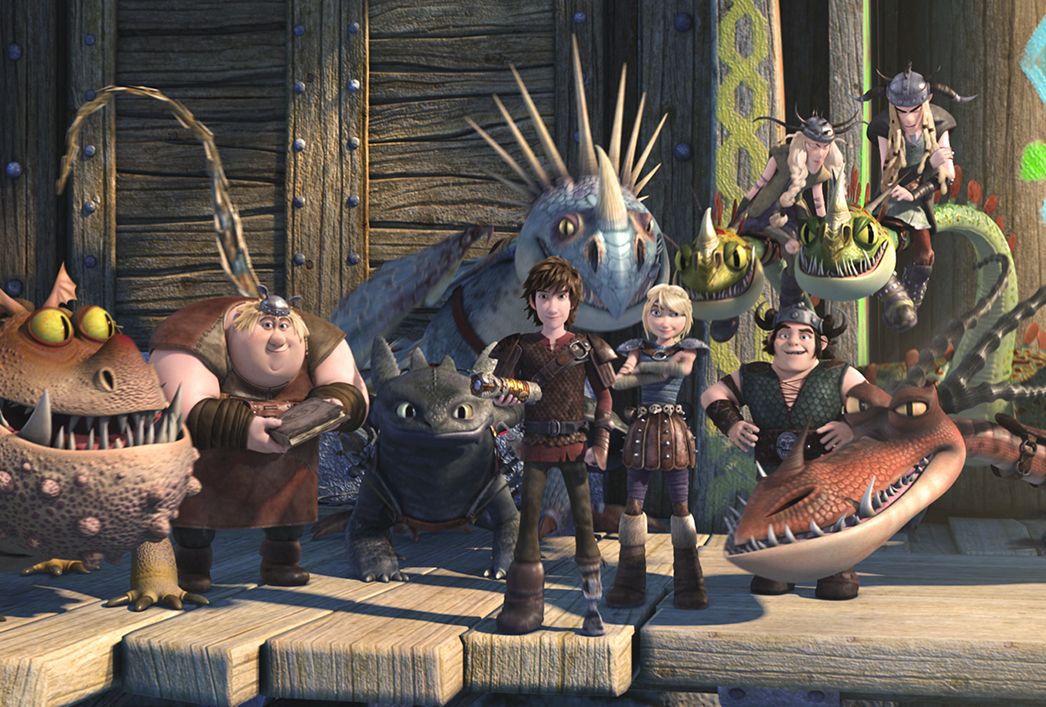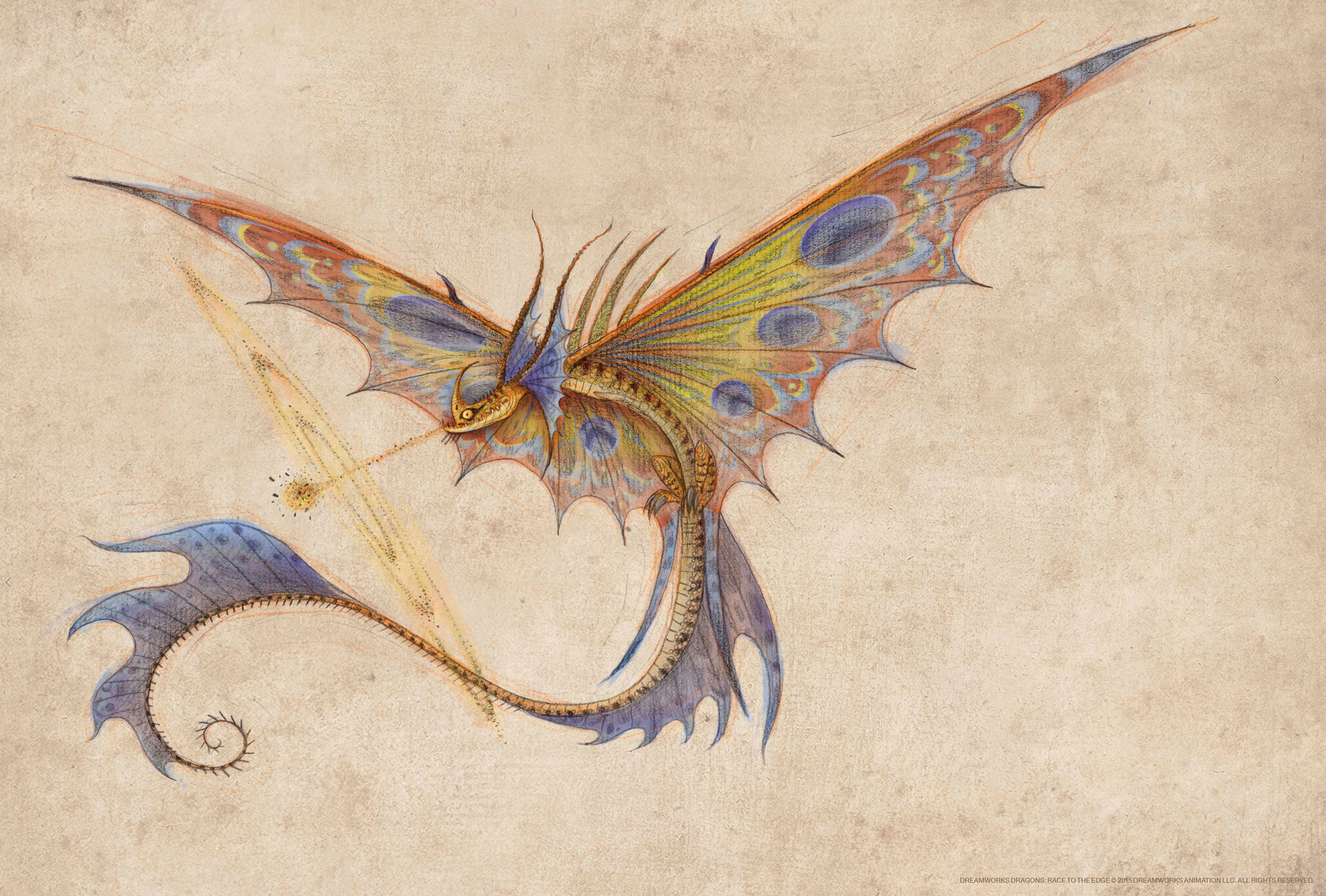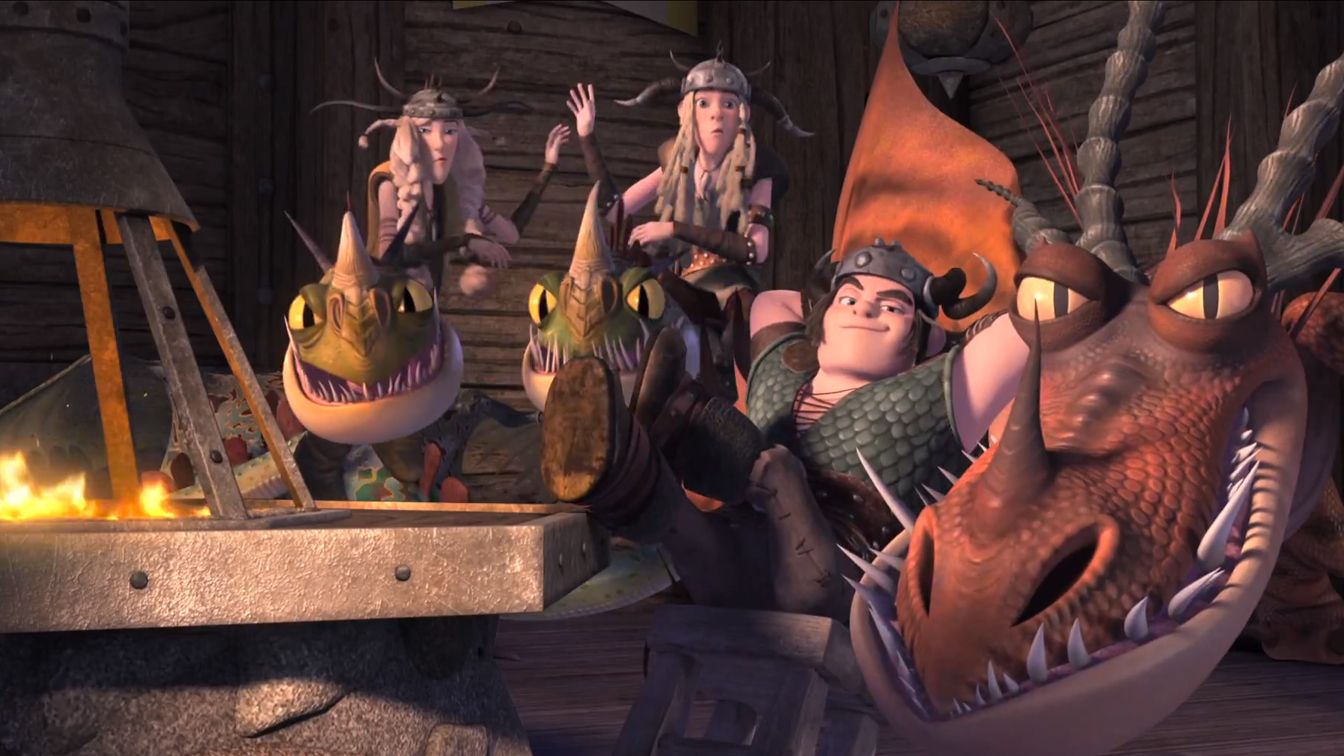DreamWorks Animation’s popular “Dragons” franchise takes flight once again this month as the television series finds a new home on Netflix.
Debuting in 2012 on Cartoon Network, “DreamWorks Dragons” is set following the events of the 2010 animated hit “How to Train Your Dragon.” The upcoming third season, subtitled “Race to the Edge,” jumps a few years into the future, and serves as a prequel to last year’s “How to Train Your Dragon 2,” with viewers following the Dragon Riders’ journey to new lands of undiscovered dragons, guided by a mysterious artifact.
Like the previous two seasons, “Riders of Berk” and “Defenders of Berk, “Race to the Edge” will allow fans to learn more about supporting characters as the broader story is explored.
Executive Producers Art Brown and Doug Sloan spoke with reporters at WonderCon 2015 about developing the new series, keeping continuity with the films, how technological advances affect their scripts, balancing a large cast of characters, and the future of the franchise.
How do you make sure the movies and the TV shows stay cohesive?
Art Brown: We're in pretty close contact with Dean [DeBlois], writer/director of the movies. We check with him when -- before the season, we break the season: We say, "This is the direction we're going to go. Does it step on anything?" Sometimes he'll say, "Yeah, can you adjust it because I want to do this in the next movie."
Doug Sloan: We had much more of an issue in the previous iteration of the show because we didn't know what the sequel was really going to be. So we were sort of writing in the dark. But going forward with Netflix, we know where the show's going because we've seen the movie. Our show is the prequel to the sequel, so we know everything that's going to happen [and] pretty much can just sort of align to that.
Brown: There's certain things we know we can't do in the series [because they happen in the movie]...There are bad guys throughout the series. You get a sense that they're working for this big guy and we'll set that sort of stuff up. There's just certain things that we stay away from. But like Doug said, it's pretty self-explanatory, I guess.
Sloan: The great thing is we get to introduce things like the flight suit – it's in the second movie – and the Dragon Blade, that's in the second movie, the flaming sword, and how they came to be. How did Stoick get a dragon, how did Gobber get Grump? We get to put that in the series. And so the audience will know how they got from the first movie to the second movie through the TV series.
Sloan: It’s great. I mean we're really, really lucky that we have the relationship we do with Dean and [producer] Bonnie Arnold. And we really do check in with each other. And Gregg Taylor is an executive at DreamWorks who's a movie executive primarily, but he also works on our show. So he really is in the loop.
Brown: We check with him a lot and if we don't have a chance to talk with Dean or Bonnie, we can talk to Gregg. But they're so accessible. Honestly, we'll shoot Dean an email and just go, "Hey, man, we're thinking of this for an episode."
Sloan: "What do you think?"
Brown: "Are you cool with it?" Usually he'll be like, "Go for it."
The freedom that Netflix offers, is it different from what you guys had at Cartoon Network?
Brown: For sure. The fact that the kids are older gives you freedom to tell different types of stories, which is really cool.
Sloan: And I think DreamWorks is very passionate about their properties, and I think partnering with Netflix was brilliant because Netflix allows DreamWorks the freedom to really tell the stories the way DreamWorks wants to tell the stories. Which allows us the freedom to do the same ... We're basically allowed to do, within the parameters of the movies and stuff, what we want to do. And the cool thing is that Netflix really pushed us to make something new.
Brown: They wanted a new show. They wanted something completely different -- looks different, sounds different, feels different. And when you see it, it really does feel very different. It's a really different show. And then Cartoon Network's series was great. It was awesome.
Sloan: And you look back at that series, just us having grown as writers throughout the course of these episodes, getting to know the characters better, our directors, our animators, everybody. We're doing stuff now that is just crazy. We couldn't even come close to this.
Brown: And technology has changed in five years or four years. The interaction with water that we have now that we couldn't have before, the flocks of dragons we could never have done before.
Sloan: And we've created crowd systems and things like that so we can do this stuff for TV.
Was the plan always to have another series to lead up to the sequels?
Brown: Well, I think the plan after the first movie was definitely to [focus on the] kids, they've [befriended] the dragons, now how do they live with them – that was definitely the plan for the series. And I think once the series had success, I think then at that point it was sort of, "We know that we're going to do something." We just didn't know what yet. So finding out and reading and knowing what the sequel was and we were able to say, "What if we do it this way?" The sequel ends and it's sort of a “to be continued,” so the third movie is going to pick up right where that left off, so there's no time in there to do anything. That's why we said, "Let's do the prequel to the sequel."
Sloan: Yeah. And we really didn't know whether we were going to do them as older kids or younger kids right up until right before we started writing the show.
Brown: We wrote the first 10 scripts age-neutral so we could pull the trigger and go either way. But it was cool that we were able to age them up because there are new rigs, there are new -- it just gives you a whole new storytelling. And it infuses, I think for us and for our writers or for our team, it infuses a new energy if you feel like something's new and you just get juiced.
In this series, what sort of relationships will we see Hiccup go through? Will there be any romance in this series?
Brown: There will be. I mean, when we start the sequel, they're obviously at a different place. So now we don't lean too heavy into it because our core audience is still kids. But being on Netflix we're able, because we're aged up too, we're able to lean into it a little bit. So by the time these seasons butt up against the sequel, we'll definitely have set that up. And we'll also have set up the Fishlegs/Snotlout/Ruffnut triangle – Fishlegs is involved in a sort of relationship with somebody –
Sloan: But it's not Ruffnut.
Brown: Yeah. So you don't see it coming. And it's really cute. So we get to do some stuff like that. The key relationship – one is Hiccup and Toothless obviously. We have a saying, "Where is Toothless?" In the script, if we're looking at a script, reading an outline, we'll just write, "WT?" "Where's Toothless?" They need to be in there, that drives the story. But the flip side is that because we do a series and we have spent so much time with these characters, we're able to --
Sloan: Do a Tuffnut story, do a Snotlout story, or Tuff and Ruff.
Brown: Stuff they just don't have time for in the movie. So we get to do that, which is fun. There's an episode where Tuffnut thinks he gets bitten by a were-dragon and he's turning into a Lycanwing -- that's what it's called -- just some really fun episodes we get to do. We break the season, we always have a board and we look at it and we're always, like, "Who haven't we had in a while?" Obviously you're going to have your Hiccup and Toothless subject episodes. But then you're like, "OK, we need an Astrid episode, let's have a Fishlegs episode."
Sloan: We've never put Tuffnut and Astrid together. Let's do that. We've never put Snotlout and Fishlegs along together, let's do that.
Brown: It's always fun to pair them up.
You were discussing the technology, how in a couple years it can advance by leaps and bounds. When you are writing an episode, does that ever come into consideration? What you can and can't do?
Brown: All the time, but our visual-effects supervisor says to us, "Keep writing things that we can't do." So that's our job, to push the envelope. Obviously, we don't ever have our writers do that. We let them write. We don't worry them with that because we just want their creative process to go...if we're pushing the envelope, if we can't do it, then we'll figure out, "OK, what can we do?" And we'll adjust it accordingly.
Sloan: But it helps them if we write stuff they can't do to force to invent new ways to do it. And our effects supervisor literally writes the programs that allow us to do some of the things we do. And it's amazing what is difficult in CG animation, like a building breaking apart, or going underwater, but just going underwater like this is really difficult.
Brown: Underwater, you can do. Underwater, above water --
Sloan: But going into the water, entering the water, is very difficult.
Brown: Character density is a big thing. A lot of characters, a few of our kids and dragons all in one shot, that's a lot of animation going on. Everybody has to be animated, that's very time-consuming for animators, so we have to be conscious of that stuff. And how do you shoot a scene where you can do a quick set-up, and they go in for a closer shot -- that's more manageable. That's where our directors come in.
Sloan: But at the center of it all is the story. If you're telling a good story, there's always a way to do it. We always figure out a way to make it look good.
Brown: And there's stuff sometimes, you go, "All right, we can't use a new location because we've used a lot of them. So how do we re-use the location and dress it differently?" It's very similar – he and I started in live-action and 3D animation is very similar to that because everything costs --
Sloan: Everything's real.
Brown: A prop is a prop.
Sloan: ... It just lives in a virtual world. But everything is real. So you have to think about it like that.
Brown: So our background helps with that, because sometimes you shoot something and you know you need a crowd. But you go, "OK, if we shoot this a certain way and we use sound design to tease the crowd, you'll do a quick couple shots, set it up, and then you get the feeling of the crowd around."
Sloan: In three or four years, [it] won't matter. I think they'll be able to do whatever they want, basically.
On casting first-time voice actors and movie sound-alikes:
Brown: We just talked about that before. There's always a decision to be made when you cast a voice-alike or a new actor. Sometimes you get lucky. Sometimes [you can get] the people who can match the voices and are great actors. Sometimes you need to forgo the voice match because you don't want them worrying about that. You want them acting. So, like, with Jonah [Hill who voices Snotlout], it's hard to match Jonah. It's very specific.
Sloan: We auditioned hundreds of people, couldn't find anyone even came close.
Brown: [We cast] this guy Zack Pearlman to do Snotlout and he has his own voice. But he has the attitude and he was in the general range.
Sloan: But he's also a little more maniacal and a little more not as cool and not as --
Brown: A little wackier.
Sloan: Which is great for the show.
Brown: Yeah, because we always want to lean into that. But the guys doing Stoick and Gobber are great ... even with our sound-alikes, our Stoick and I feel – and this is sometimes just how they wanted to direct them in the movies and nothing to do with anybody's acting ability – but Gerard Butler was much sterner and didn't have a whole lot of warmth to him and comedy to him. And we've been able to do that.
Sloan: But he wasn't supposed to. He played that big powerful chief very, very well. But ours, we examined that relationship so closely, we needed a warmth. So we we're very lucky with the guys we've got.
Brown: And, again, it goes to having to spend hundreds upon hundreds of minutes with these characters, you have to find levels for them. We have to find new ways of comedy for the twins. Hitting each other in the head is fun for so long. But then you've got to find ways, "How are these guys funny? What makes them funny?" We've had these guys invent ice cream.
Sloan: Gravity.
Brown: Gravity, in their own idiotic ways.
Sloan: Penicillin.
Brown: Yeah. Penicillin. Moldy bread. They do episodes where they're the Greek chorus in an episode where they're talking about "theater."
Sloan: [faux British accent] "Excellent."
Brown: [faux British accent] "Excellent job."
Sloan: [faux British accent] "Wonderful climax."
And you already mentioned there's going to be a third movie. You have two series – two seasons?
Sloan: It's actually four mini-seasons. It's four drops of 13. First is in June and the second one is later in the year.
Brown: Yeah, I think it's like every six months or so, there'll be another 13.
Sloan: So four drops of 13.
Are there already conversations about what the next series is going to be?
Sloan: Not with us.
Brown: There's probably going to be. There's little stuff, things that we make.
Sloan: We hope there is. We would love to keep doing it. There is no definitive plan so far. It certainly wouldn't the worst thing.
Brown: We've not completely tapped out [of "Dragons"] stories yet.
Sloan: No, I've got a ton more.
Brown: Yeah, you've got more in there. Yeah, a ton more.
”DreamWorks Dragons: Race to the Edge” premieres June 26 on Netflix.

